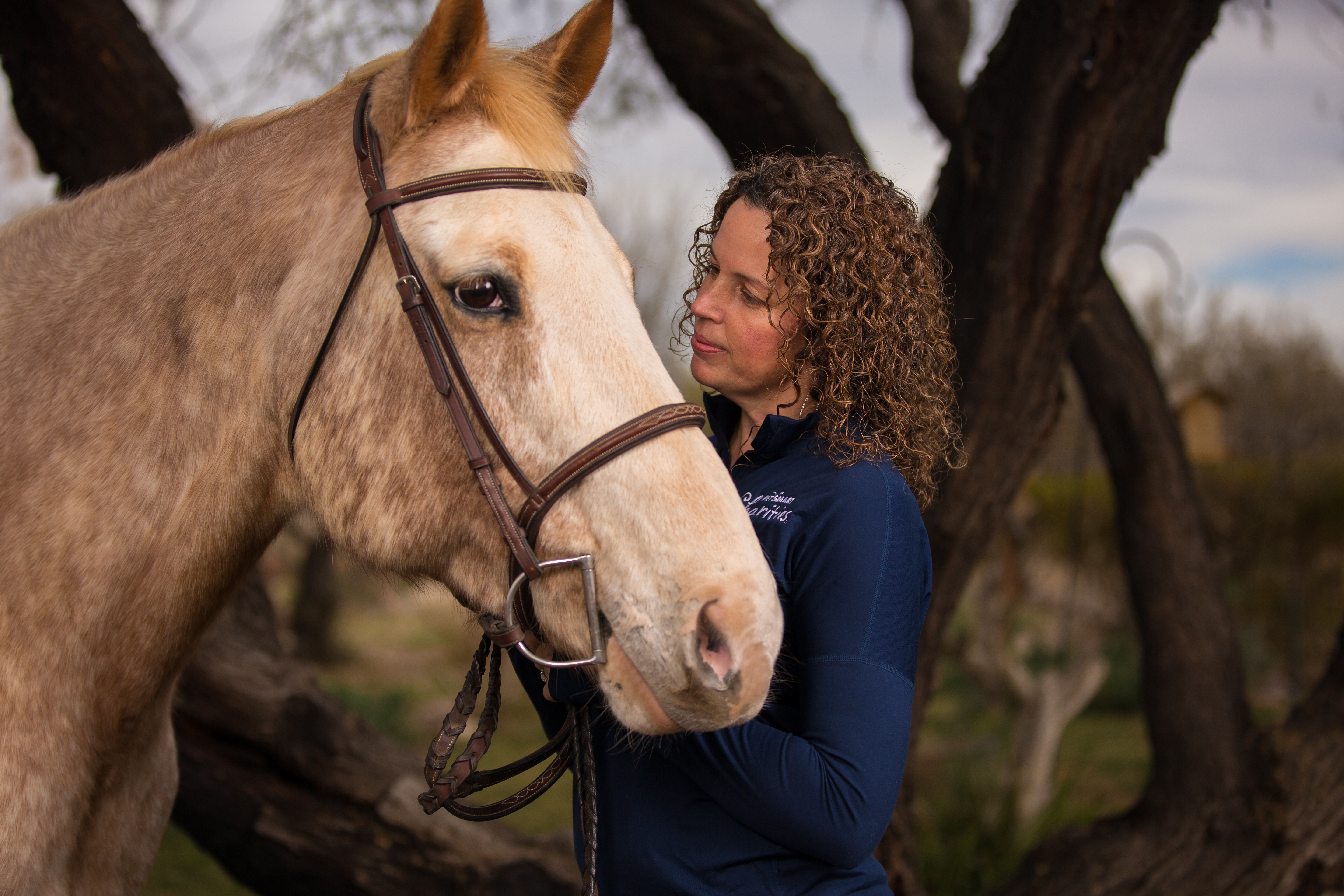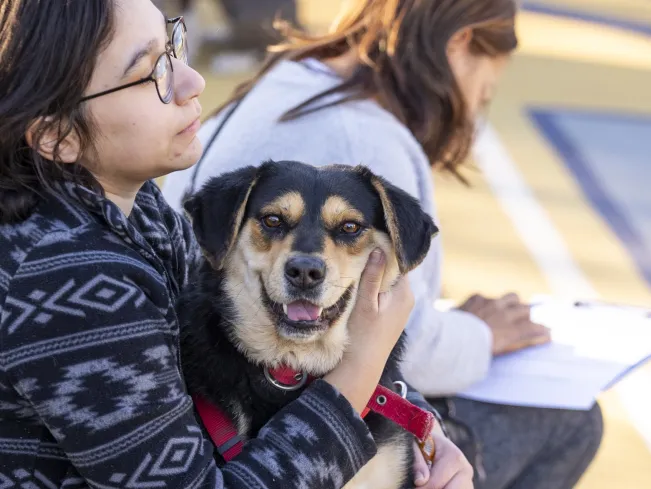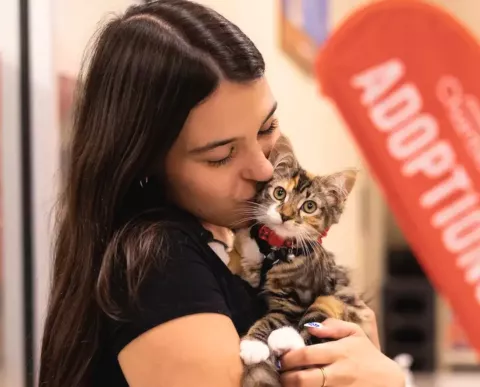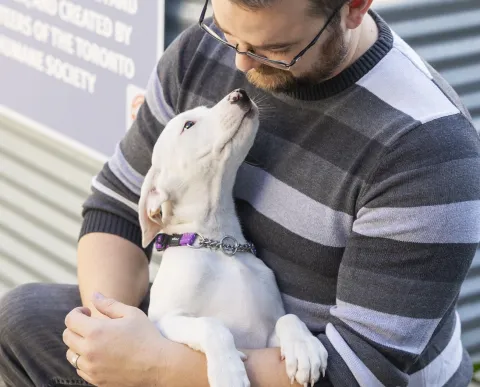Harvey felt like it was barely in the rearview mirror when the threat of another impending storm made the news. Hurricane Irma was in the Atlantic Ocean moving toward several Caribbean islands. Meanwhile, experts predicted some level of a direct hit on Florida. I had prepared my own pets and farm animals for hurricanes before, but this time I was on the other side of the country working at our PetSmart Charities headquarters in Arizona as the networks showed the size of Irma increasing every hour. Even the best planning gets called into question when one is struck with the realization that someone else might have to care for your pets during a disaster.
Why Prepare?
Consider Natalia. She’s a 160 pound rescued Caucasian Ovcharka. Yes, that’s a dog (see below). Saved from a cruelty case in New Hampshire where a drug dealer was attempting to breed protective guard dogs. Natalia carries that 160 pounds with grace until a threat is imminent. When a threat is sensed, she goes into a hypervigilant mode where instinct from hundreds of years of breeding to guard territory and livestock in the Caucus mountains of Russia kicks in. Can you imagine a dog like this in a pet-friendly hurricane shelter where you hold your miniature dachshund on your lap and I try to manage mine on our cots that sit less than 18 inches apart? I can see your eyes getting wider as you consider the possibility. Not to worry, Natalia can’t go to those places and I know it.

Your dog might be easy, small, well-behaved, or any number of positive things but during a crisis or when disaster hits, finding ways to manage each pet that we love becomes of great importance to us. That pet represents companionship, normalcy, and often, emotional relief during trying times. There aren’t many Natalia’s out there, but your pet might have special medication or special food or may have some other special behavioral considerations besides extreme protective instincts. If you need to leave your home, preparation means a great deal of comfort for your pet and invaluable peace-of-mind for you.
What Can You Do to Be Ready?
As I faced the reality of trying to travel 2500 miles back to a state that wasn’t allowing flights in or out, my mind was playing through every option for my animals. The current predictions for Irma brought her as a Category 3 or 4 storm right over my Florida home where my husband, college-aged children and a farm full of animals lay in wait. Being the resident animal-expert in our family, I was doing my best to convey over the phone where each veterinary vaccination record was kept, the extra crates, leashes and halters we owned, and the bins to transfer food into for evacuation. We are well-prepared owners but with three horses, two mini-donkeys, two giant breed dogs and cat (who I might add has personality comparable to the others combined), even we found ourselves scrambling.
Your emotions will be the same: a sincere desire to make sure every member of your family will be safe throughout the entirety of the storm, evacuation, or relocation. You will be making decisions without time to consider your options and, with each passing moment, the options you can consider become more limited. Hotels that are pet-friendly become booked, your internet might not be working for research on pet-friendly shelters, or the lines of traffic moving out of your area will feel prohibitive at best, paralyzing at worst. All the while you are thinking, “Where did I put Fluffy’s vet records and cat carrier?”
Even the simplest of pets have important preparedness needs. Here are a few for the most common household pets like dogs and cats (at the end of this post, I link to other resources for equine, livestock, reptiles, and other animals if you happen to have a menagerie like me):
Pack a go-kit of the following standing supplies:
-
Extra leash and collar (Always great to have an ID tag with pet’s name and your phone number as well)
-
Food and water bowls
-
Extra copy of vaccination record with veterinarian contact information on it. Feel free to ask the vet’s office to make you a second copy when you pay your bill
-
Current photo of your pet. Bonus tip: carry a photo of their complete body with any unique markings or a photo of them with you in case you get separated and need to prove ownership
-
Basic first aid items
-
Plastic bags for dog refuse or a small amount of kitty litter for cats
-
Blanket or newspaper for lining crate
-
Manual can opener if you happen to feed wet food
-
List of any special needs, medications, or diets for each pet (can also be taped to the back of the photo to reassure caregivers “Fluffy gets ID food”)
-
Then, when it’s time to go, be sure to add the following items:
-
Week supply of food and water (Make sure to mark special foods with prescription information or pet’s name if you have multiple pets and multiple types of food)
-
Medications clearly marked (A cooler with ice is sometimes needed for medications)
-
Crate or carrier for containment - Special notes on crates: I hear many people talk about how they feel that crates are cruel likely picturing the sad stories on TV of animals in crates. During stressful moments, animals often hide or flee. Think of the cat that hides under the bed when scared or the dog that runs during a thunderstorm. By providing your pet a crate, you give it a place to hide in that stressful moment and save your animal from escaping.
Where Can You Go When Danger is Coming?
As my family tries to pull together their items for a potential evacuation and manage the animals in my absence, I’m formulating a flight to Atlanta, Georgia and booking a rental car so I can drive toward the storm and my family. Meanwhile, we are investigating options for where we can transport our entire crew and stay for several days.
Horses make that far harder than it sounds.
But, the great news for you dog and cat owners is that there are many options, today, for where you can go.
Make a list in advance of places that will accept your particular species of animals and any limitations they may place on pets. Don’t stop at one option, compile any number of options, even ones you think you will never need. Here are some examples of options you might consider:
- Hotels that are pet-friendly and don’t have breed restrictions for dogs or cats
- Pet-friendly disaster shelters in your immediate area and surrounding counties
- Local humane societies or SPCA’s that serve as a disaster boarding facility
- Campgrounds outside of the storm zone that can serve as an evacuation center
- Your county’s evacuation centers and learn whether they are pet-friendly or not
- Boarding facilities that are outside of your immediate area
- Family or friends that live within driving distance but would be out of harm’s way. And, if you want to stay friends, ask in advance if it’s ok to bring your pets.
“In the Ready” is a Great State of Being
The late-night drive from Atlanta to my home in Florida was both exhilarating and sobering. I was driving south on Interstate 75 and a sheer wall of headlights was heading north to escape the wrath of Irma. Every rest area was full of cars, the sides of the highway speckled with vehicles that had run out of gas while trying to beat the weather and the sky had that odd hue to it that comes before a hurricane hits. It was only a five-and-a-half hour drive but it seemed to drag on as my mind raced between the fate of my exiting highway mates and the readiness of my family and farm. When I arrived about 5:00 AM, a mere twelve hours before the first signs of Irma would show at our property, I was greeted by a tired family surrounded by lots of supplies ready to load into trucks and trailers. Having seen the state of the main highways, we began mapping alternate routes to escape. It was about that time we learned that Irma was slowing and downgrading. What we feared would be a Category 4 impact at our house looked more to be a Category 2 by the time she reached us. With the peace of knowing we were ready to leave if need be, we reconsidered all options and determined that our Florida version of a high-and-dry property (a whole 90 feet above sea level) and our poured concrete house would likely be the best bet for our difficult-to-house collection of animals. But, it was being “in the ready” that allowed us the luxury of time and headspace to contemplate those options and make a sound decision.
Being “in the ready” for your pets allows you to focus on other important decisions during a potential evacuation or relocation. You will be able to remember things like your toothbrush or your own medications because you aren’t cluttering your thoughts with the myriad of needs for your entire family, four-legged or two-legged. While that sounds oversimplified, I promise it will be of great comfort to you when faced with the chaos that can come during a disaster.
The Calm After the Storm
A small category 2 version of Hurricane Irma passed over us that night. All in all, we felt blessed that while we had damage to the farm, it was not severe, and felt relieved that all members of the family came through safely. As we cleaned up and finding out how to help others, we had no idea that yet a third storm would be bearing down on Puerto Rico and other islands shortly.
My husband who has a long history of serving affected communities during disasters always says, “Over prepare to be underwhelmed, or under prepare to be overwhelmed.” He’s a pretty smart guy. Wherever you live, it’s a statement you can live by. Where you are it might be severe ice storms, or river flooding, or wildfires, or lava flows – whatever the case – your preparedness for your pets will help you weather the storm, both figuratively and literally, with less stress and a higher likelihood of safety. The worst possible outcome is that you feel less than prepared for your pets and make a choice to not leave because you aren’t prepared, and then stare face to face into a tragedy that could have been avoided.
To bring it all back together:
- Recognize that preparing is well within your power and knowledge
- Prepare by assembling the needed elements of your “go-kit”
- Research potential locations for evacuation if it is needed
- Rest easy because you, after all, are now ready!
As promised, links will follow this blog post with other resources for pets beyond dogs and cats, and I encourage you to look for upcoming blogs in this series about how PetSmart Charities help organizations respond when disaster strikes (we are still helping Puerto Rico after Maria hit last year), and what you can do to help others when disasters hit other parts of the country and you are left to watch wide-eyed on the evening news.
Thanks for joining us to learn about being prepared and, remember, “Be over prepared to be underwhelmed and be underprepared to be overwhelmed.”
Resources:
Horses
http://www.horsefund.org/resources/Disaster%20Preparedness%20for%20Horses.pdf
https://www2.vetmed.ucdavis.edu/ceh/local_resources/pdfs/HRFall2014-EEPPosterPRINT.pdf
Reptiles
https://redrover.org/resource/disaster-tips-for-reptiles-and-amphibians/
Livestock
https://www.usda.gov/sites/default/files/documents/usda-livestock-preparedness-fact-sheet.pdf












